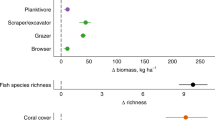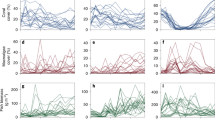Abstract
Human impact increasingly alters global ecosystems, often reducing biodiversity and disrupting the provision of essential ecosystem services to humanity. Therefore, preserving ecosystem functioning is a critical challenge of the twenty-first century. Coral reefs are declining worldwide due to the pervasive effects of climate change and intensive fishing, and although research on coral reef ecosystem functioning has gained momentum, most studies rely on simplified proxies, such as fish biomass. This lack of quantitative assessments of multiple process-based ecosystem functions hinders local and regional conservation efforts. Here we combine global coral reef fish community surveys and bioenergetic models to quantify five key ecosystem functions mediated by coral reef fishes. We show that functions exhibit critical trade-offs driven by varying community structures, such that no community can maximize all functions. Furthermore, functions are locally dominated by few species, but the identity of dominant species substantially varies at the global scale. In fact, half of the 1,110 species in our dataset are functionally dominant in at least one location. Our results reinforce the need for a nuanced, locally tailored approach to coral reef conservation that considers multiple ecological functions beyond the effect of standing stock biomass.
This is a preview of subscription content, access via your institution
Access options
Access Nature and 54 other Nature Portfolio journals
Get Nature+, our best-value online-access subscription
$29.99 / 30 days
cancel any time
Subscribe to this journal
Receive 12 digital issues and online access to articles
$119.00 per year
only $9.92 per issue
Buy this article
- Purchase on Springer Link
- Instant access to full article PDF
Prices may be subject to local taxes which are calculated during checkout




Similar content being viewed by others
Data availability
All data needed to reproduce the figures are available on GitHub (https://github.com/nschiett/global_proc) and figshare (https://doi.org/10.6084/m9.figshare.13285901.v1). All empirical data that were used to estimate parameters for bioenergetic modelling (Supplementary Information) will be available on figshare (https://doi.org/10.6084/m9.figshare.19134446.v1) after a two-year embargo.
Code availability
All code to reproduce the figures are available on GitHub (https://github.com/nschiett/global_proc) and figshare (https://doi.org/10.6084/m9.figshare.13285901.v1).
References
Welti, N. et al. Bridging food webs, ecosystem metabolism, and biogeochemistry using ecological stoichiometry theory. Front. Microbiol. 8, 1298 (2017).
Ceballos, G. et al. Accelerated modern human-induced species losses: entering the sixth mass extinction. Sci. Adv. 1, e14002 (2015).
Hughes, T. P. et al. Global warming and recurrent mass bleaching of corals. Nature 543, 373–377 (2017).
Pauly, D. et al. Towards sustainability in world fisheries. Nature 418, 689–695 (2002).
Bellwood, D. R., Streit, R. P., Brandl, S. J. & Tebbett, S. B. The meaning of the term ‘function’ in ecology: a coral reef perspective. Funct. Ecol. 33, 948–961 (2019).
Williams, G. J. et al. Coral reef ecology in the Anthropocene. Funct. Ecol. 33, 1014–1022 (2019).
Brandl, S. J. et al. Coral reef ecosystem functioning: eight core processes and the role of biodiversity. Front. Ecol. Environ. 17, 445–454 (2019).
Cinner, J. E. et al. Meeting fisheries, ecosystem function, and biodiversity goals in a human-dominated world. Science 368, 307–311 (2020).
Mouillot, D. et al. Functional over-redundancy and high functional vulnerability in global fish faunas on tropical reefs. Proc. Natl Acad. Sci. USA 111, 13757–13762 (2014).
Mora, C. et al. Global human footprint on the linkage between biodiversity and ecosystem functioning in reef fishes. PLoS Biol. 9, e1000606 (2011).
Barneche, D. R. et al. Scaling metabolism from individuals to reef-fish communities at broad spatial scales. Ecol. Lett. 17, 1067–1076 (2014).
McIntyre, P. B. et al. Fish distributions and nutrient cycling in streams: can fish create biogeochemical hotspots? Ecology 89, 2335–2346 (2008).
Allgeier, J. E., Layman, C. A., Mumby, P. J. & Rosemond, A. D. Consistent nutrient storage and supply mediated by diverse fish communities in coral reef ecosystems. Glob. Change Biol. 20, 2459–2472 (2014).
Morais, R. A. & Bellwood, D. R. Pelagic subsidies underpin fish productivity on a degraded coral reef. Curr. Biol. 29, 1521–1527.e6 (2019).
Morais, R. A., Connolly, S. R. & Bellwood, D. R. Human exploitation shapes productivity–biomass relationships on coral reefs. Glob. Change Biol. 26, 1295–1305 (2020).
Barneche, D. R. et al. Body size, reef area and temperature predict global reef-fish species richness across spatial scales. Glob. Ecol. Biogeogr. 28, 315–327 (2019).
Schiettekatte, N. M. D. et al. Nutrient limitation, bioenergetics and stoichiometry: a new model to predict elemental fluxes mediated by fishes. Funct. Ecol. 34, 1857–1869 (2020).
Schramski, J. R., Dell, A. I., Grady, J. M., Sibly, R. M. & Brown, J. H. Metabolic theory predicts whole-ecosystem properties. Proc. Natl Acad. Sci. USA 112, 2617–2622 (2015).
Morais, R. A. & Bellwood, D. R. Global drivers of reef fish growth. Fish Fish. 19, 874–889 (2018).
Hood, J. M., Vanni, M. J. & Flecker, A. S. Nutrient recycling by two phosphorus-rich grazing catfish: the potential for phosphorus-limitation of fish growth. Oecologia 146, 247–257 (2005).
Barneche, D. R. & Allen, A. P. The energetics of fish growth and how it constrains food-web trophic structure. Ecol. Lett. 21, 836–844 (2018).
Brandl, S. J. et al. Demographic dynamics of the smallest marine vertebrates fuel coral reef ecosystem functioning. Science 364, 1189–1192 (2019).
Lefcheck, J. S. et al. Tropical fish diversity enhances coral reef functioning across multiple scales. Sci. Adv. 5, eaav6420 (2019).
Topor, Z. M., Rasher, D. B., Duffy, J. E. & Brandl, S. J. Marine protected areas enhance coral reef functioning by promoting fish biodiversity. Conserv. Lett. 12, e12638 (2019).
Bellwood, D. R., Hughes, T. P. & Hoey, A. S. Sleeping functional group drives coral-reef recovery. Curr. Biol. 16, 2434–2439 (2006).
Darling, E. S. & D’agata, S. Coral reefs: fishing for sustainability. Curr. Biol. 27, R65–R68 (2017).
Graham, N. A. J. et al. Human disruption of coral reef trophic structure. Curr. Biol. 27, 231–236 (2017).
Graham, N. A. J. et al. Dynamic fragility of oceanic coral reef ecosystems. Proc. Natl Acad. Sci. USA 103, 8425–8429 (2006).
Stuart-Smith, R. D., Brown, C. J., Ceccarelli, D. M. & Edgar, G. J. Ecosystem restructuring along the great barrier reef following mass coral bleaching. Nature 560, 92–96 (2018).
Burkepile, D. E. et al. Nutrient supply from fishes facilitates macroalgae and suppresses corals in a Caribbean coral reef ecosystem. Sci. Rep. 3, 1493 (2013).
Graham, N. A. J. et al. Changing role of coral reef marine reserves in a warming climate. Nat. Commun. 11, 2000 (2020).
Reynolds, R. W. et al. Daily high-resolution-blended analyses for sea surface temperature. J. Clim. 20, 5473–5496 (2007).
Froese, R., Thorson, J. T. & Reyes, R. B. A Bayesian approach for estimating length–weight relationships in fishes. J. Appl. Ichthyol. 30, 78–85 (2014).
Froese, R. & Pauly, D. FishBase (2018); https://www.fishbase.in/home.htm
Parravicini, V. et al. Delineating reef fish trophic guilds with global gut content data synthesis and phylogeny. PLoS Biol. 18, e3000702 (2020).
Brown, J. H., Gillooly, J. F., Allen, A. P., Savage, V. M. & West, G. B. Toward a metabolic theory of ecology. Ecology 85, 1771–1789 (2004).
Bürkner, P.-C. brms: an R package for Bayesian multilevel models using Stan. J. Stat. Softw. 80, 1–28 (2017).
Carpenter, B. et al. Stan: a probabilistic programming language. J. Stat. Softw. 76, 1–31 (2017).
Acknowledgements
We thank the staff at CRIOBE, Moorea for field support. We also thank J. Carlot, S. Degregori, B. French, T. Roncin, Y. Lacube, C. Gache, G. Martineau, K. Bissell, B. Espiau, C. Quigley, K. Landfield and T. Norin for their help in the field, G. de Sinéty and J. Wicquart for their contribution to otolith analysis, and S. Schiettekatte for proofreading the manuscript. This research was funded by the BNP Paribas Foundation (Reef Services Project) and the French National Agency for Scientific Research (ANR, REEFLUX Project, ANR‐17‐CE32‐0006). This research is the product of the SCORE-REEF group funded by the Centre de Synthèse et d’Analyse sur la Biodiversité of the Foundation pour la Recherche sur la Biodiversité and the Office Francais de la Biodiversité. V.P. was supported by the Institut Universitaire de France, and J.M.C. was supported by a Make Our Planet Great Again Postdoctoral Grant (mopga‐pdf‐0000000144).
Author information
Authors and Affiliations
Contributions
N.M.D.S. and V.P. conceived the idea. N.M.D.S., V.P., S.J.B., J.M.C. and S.V. designed the methodology. N.M.D.S., J.M.C., S.J.B., A.M., F.M., V.P., K.S.M., J.E.A. and D.E.B. collected the data. N.A.J.G., D.R.B., D.E.B., J.E.A., J.E.A.-G., G.J.E., C.E.L.F., S.R.F., A.M.F., A.L.G., M.K., Y.L., O.J.L., F.M., E.L.R., F.A.R.-Z., R.D.S.-S. and L.V. shared existing data. N.M.D.S. analysed the data and led the writing of the manuscript. All authors contributed significantly to the drafts and approved the final version for publication.
Corresponding author
Ethics declarations
Competing interests
The authors declare no competing interests.
Peer review
Peer Review File
Nature Ecology & Evolution thanks Matthew McLean, Marc Hensel and Gareth Williams for their contribution to the peer review of this work. Peer reviewer reports are available.
Additional information
Publisher’s note Springer Nature remains neutral with regard to jurisdictional claims in published maps and institutional affiliations.
Extended data
Extended Data Fig. 1 Correlations among functions.
Correlations, independent of biomass and sea surface temperature, at the locality and site levels. Dotes and lines indicate the mean estimated values and 95% credible intervals, respectively.
Extended Data Fig. 2 Posterior predictive checks of multivariate models.
a-e: Intercept-only model, f-j: model with biomass and sea surface temperature, k-o: model with all community variables.
Supplementary information
Rights and permissions
About this article
Cite this article
Schiettekatte, N.M.D., Brandl, S.J., Casey, J.M. et al. Biological trade-offs underpin coral reef ecosystem functioning. Nat Ecol Evol 6, 701–708 (2022). https://doi.org/10.1038/s41559-022-01710-5
Received:
Accepted:
Published:
Issue Date:
DOI: https://doi.org/10.1038/s41559-022-01710-5
This article is cited by
-
Remote video surveys unveil the diurnal variability of trophic-based processes by fishes on coral reefs
Coral Reefs (2024)
-
Studying functions on coral reefs: past perspectives, current conundrums, and future potential
Coral Reefs (2024)
-
Insights from the 2-year-long human confinement experiment in Grand Cayman reveal the resilience of coral reef fish communities
Scientific Reports (2023)
-
Coral settlement and recruitment are negatively related to reef fish trait diversity
Coral Reefs (2023)



